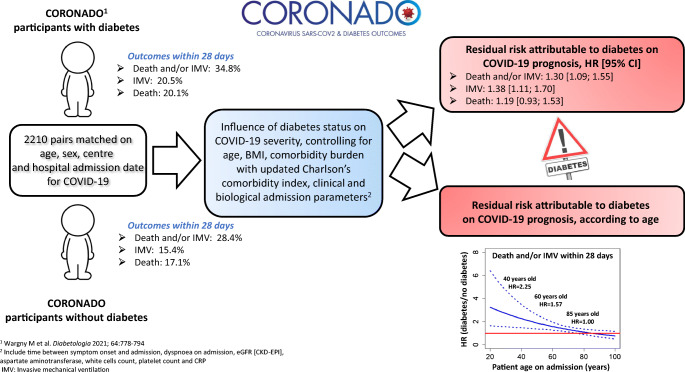[1
]GRID grid.4817.a, ISNI 0000 0001 2189 0784, CHU Nantes, CNRS, Inserm, l’institut du thorax, , Nantes Université, ; Nantes, France
[2
]GRID grid.277151.7, ISNI 0000 0004 0472 0371, CHU Nantes, Inserm CIC 1413, Pôle Hospitalo-Universitaire 11 : Santé Publique, Clinique
des données, ; Nantes, France
[3
]GRID grid.277151.7, ISNI 0000 0004 0472 0371, CHU Nantes, Pôle de Gérontologie Clinique, ; Nantes, France
[4
]GRID grid.508721.9, Service de Diabétologie, Maladies Métaboliques & Nutrition, CHU Toulouse, Institut
des Maladies Métaboliques & Cardiovasculaires, UMR1297 Inserm/UT3, , Université de Toulouse, ; Toulouse, France
[5
]GRID grid.134996.0, ISNI 0000 0004 0593 702X, Department of Endocrinology, Diabetes Mellitus and Nutrition, , Amiens University Hospital, Amiens, France; PériTox UMR_I 01, University of Picardie
Jules Verne, ; Amiens, France
[6
]GRID grid.411147.6, ISNI 0000 0004 0472 0283, Département de Diabétologie, , Centre Hospitalier Universitaire, ; Angers, France
[7
]GRID grid.477082.e, ISNI 0000 0004 0641 0297, Département de Diabétologie, , Centre Hospitalier Sud Francilien, ; Corbeil Essonne, France
[8
]GRID grid.460789.4, ISNI 0000 0004 4910 6535, Université Paris-Saclay, Le Kremlin-Bicêtre, ; Paris, France
[9
]Service endocrinologie-diabétologie-nutrition, CH Le Havre, Montivilliers, France
[10
]GRID grid.5842.b, ISNI 0000 0001 2171 2558, Épidémiologie Clinique, Centre de Recherche en Épidémiologie et Santé des Populations,
Inserm U1018, , Université Paris-Saclay, USVQ, Université Paris-Sud, ; Villejuif, France
[11
]GRID grid.414007.6, ISNI 0000 0004 1798 6865, Service d’endocrinologie et maladies métaboliques, H.I.A Bégin, ; Saint-Mandé, France
[12
]GRID grid.411158.8, ISNI 0000 0004 0638 9213, Department of Endocrinology, Diabetology and Nutrition, , Besançon University Hospital, ; Besançon, France
[13
]GRID grid.413784.d, ISNI 0000 0001 2181 7253, Department of Endocrinology, Diabetology and Nutrition, Assistance Publique Hôpitaux
de Paris, , Paris-Saclay University, Antoine Béclère Hospital, Clamart, Bicêtre Hospital, ; Le Kremlin-Bicêtre, France
[14
]GRID grid.462844.8, ISNI 0000 0001 2308 1657, Assistance Publique Hôpitaux de Paris, Département de Diabétologie, CHU La Pitié-Salpêtrière
- Charles-Foix; Inserm, UMR_S 1138, Centre de Recherche des Cordeliers, Paris 06;
Institute of Cardiometabolism and Nutrition ICAN, , Sorbonne Université, ; Paris, France
[15
]GRID grid.413780.9, ISNI 0000 0000 8715 2621, Assistance Publique Hôpitaux de Paris, Avicenne Hospital, Paris 13 University, Sorbonne
Paris Cité, Department of Endocrinology, Diabetology and Nutrition, CRNH-IdF, CINFO,
; Bobigny, France
[16
]GRID grid.508487.6, ISNI 0000 0004 7885 7602, Paris 13 University, Sorbonne Paris Cité, UMR U557 Inserm / U11125 INRAE / CNAM /
Paris13 University, Nutritional Epidemiological Research Unit, ; Bobigny, France
[17
]GRID grid.411535.7, ISNI 0000 0004 0638 9491, Hôpital de la Conception, Service d’Endocrinologie, Maladies Métaboliques et Nutrition,
; Marseille, France
[18
]GRID grid.5399.6, ISNI 0000 0001 2176 4817, Inserm, INRAE, C2VN, , Aix Marseille Univ, ; Marseille, France
[19
]Department of Endocrinology and Diabetology, Hospital of Pontoise, Pontoise, France
[20
]GRID grid.411296.9, ISNI 0000 0000 9725 279X, Département Diabète et Endocrinologie, , Hôpital Lariboisière, Assistance Publique Hôpitaux de Paris, ; Paris, France
[21
]GRID grid.508487.6, ISNI 0000 0004 7885 7602, Inserm UMRS 1138, , Université Paris Diderot–Paris VII, Sorbonne Paris Cité, ; Paris, France
[22
]GRID grid.489921.f, Centre Hospitalier Saint Joseph Saint Luc, ; Lyon, France
[23
]GRID grid.412220.7, ISNI 0000 0001 2177 138X, Département d’Endocrinologie, Diabétologie et Nutrition, , Hôpitaux Universitaires de Strasbourg, ; Strasbourg, France
[24
]GRID grid.460749.8, ISNI 0000 0004 0634 6424, Unité de Diabétologie, Endocrinologie et Nutrition, , Centre Hospitalier de Gonesse, ; Gonesse, France
[25
]Service de Diabétologie, Pitié-Salpêtrière, Paris, France
[26
]GRID grid.121334.6, ISNI 0000 0001 2097 0141, Department of Endocrinology-Diabetology-Nutrition, CHU Montpellier, , University of Montpellier, ; Montpellier, France
[27
]GRID grid.121334.6, ISNI 0000 0001 2097 0141, PhyMedExp, CHU Montpellier, Inserm, CNRS, , University of Montpellier, ; Montpellier, France
[28
]GRID grid.7849.2, ISNI 0000 0001 2150 7757, Centre du Diabète DIAB-eCARE, Hospices Civils de Lyon et Laboratoire CarMeN, Inserm,
INRA, INSA, , Université Claude Bernard Lyon 1, ; Lyon, France
[29
]GRID grid.484642.8, ISNI 0000 0001 0807 394X, Société Francophone du Diabète (SFD), ; Paris, France
[30
]GRID grid.410463.4, ISNI 0000 0004 0471 8845, Department of Diabetology, Endocrinology, , Metabolism and Nutrition Lille University Hospital, ; Lille, France
[31
]GRID grid.452394.d, European Genomic Institute of Diabetes, , University School of Medicine, ; Lille, France
[32
]GRID grid.412370.3, ISNI 0000 0004 1937 1100, Assistance Publique Hôpitaux de Paris, Saint-Antoine Hospital, Reference Center of
Rare Diseases of Insulin Secretion and Insulin Sensitivity (PRISIS), Department of
Endocrinology, ; Paris, France
[33
]GRID grid.462844.8, ISNI 0000 0001 2308 1657, Inserm UMRS 938, Saint-Antoine Research Center, , Sorbonne University, ; Paris, France
[34
]GRID grid.492689.8, ISNI 0000 0004 0640 1948, Service d’Endocrinologie, Diabétologie et Nutrition, , Hôpital Nord Franche-Comté, ; Trévenans, France
[35
]GRID grid.11166.31, ISNI 0000 0001 2160 6368, Clinical Investigation Centre CIC1402, , University of Poitiers, Inserm, CHU Poitiers, ; Poitiers, France
[36
]Fondation Francophone pour la Recherche sur le Diabète (FFRD), Paris, France



